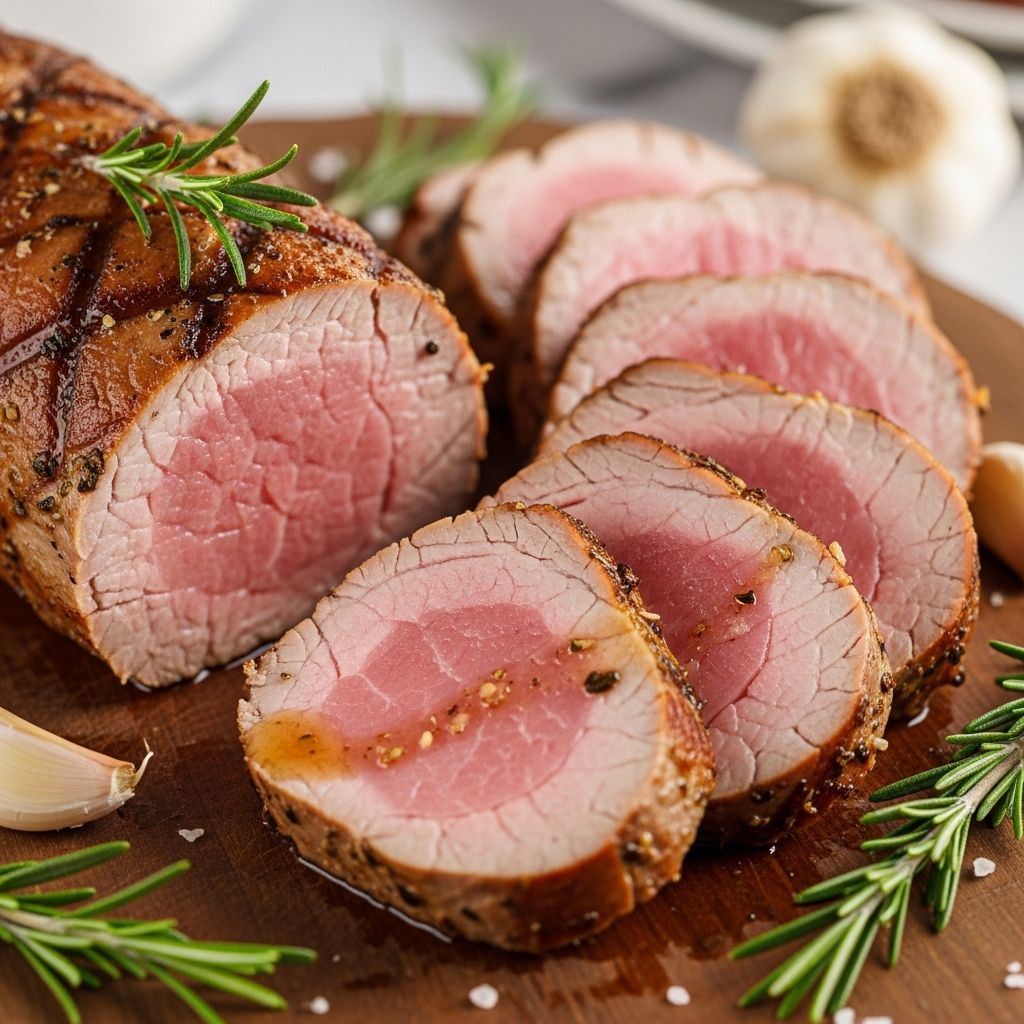Sous Vide Pork Tenderloin: Ultimate Guide For Juicy Results
Every slice reveals perfectly balanced moisture and taste through temperature precision.

Sous Vide Pork Tenderloin: The Ultimate Juicy and Flavorful Method
Sous vide cooking has revolutionized the way home cooks and professionals approach pork tenderloin, one of the leanest and most forgiving cuts. Using gentle, precise temperature control, sous vide allows for pork that’s incredibly juicy, tender, and evenly cooked from edge to edge, free from guesswork or dry results. This guide explores every aspect of crafting perfect sous vide pork tenderloin, demystifying key techniques, time and temperature choices, flavor infusions, finishing tricks, and troubleshooting, so you can master this celebrated cut.
Why Choose Sous Vide for Pork Tenderloin?
Sous vide delivers consistently tender, moist pork tenderloin by controlling the exact temperature of the water bath, preventing overcooking and ensuring edge-to-edge doneness. Traditional methods often risk drying out this lean cut, but sous vide gives you absolute control over texture and juiciness.
- Consistent results: No variance—your pork is always cooked exactly to your chosen doneness.
- Maximum juiciness: Low, steady heat means minimal moisture loss.
- Ideal for meal prep: Cook ahead and finish in minutes when ready to serve.
Essential Ingredients
Flavoring sous vide pork tenderloin is straightforward, but the technique allows for endless customization. Choose seasonings that complement pork’s natural sweetness, and consider adding fat or aromatics to the bag for greater flavor.
- Pork tenderloin: 1 to 1.5 lbs, trimmed of silver skin and connective tissue.
- Salt and pepper: Generously applied before sealing.
- Optional aromatics: Fresh herbs (thyme, rosemary, sage), minced garlic, shallot slices.
- Optional fat: Olive oil, melted butter, or a few teaspoons of rendered pork fat for rich flavor.
- Optional sweet/spicy elements: A pinch of brown sugar, crushed red pepper flakes, or a touch of Dijon mustard can amplify the flavor profile.
Preparing Pork Tenderloin for Sous Vide
Good prep ensures the best texture and flavor infusion during sous vide.
- Trim: Remove silver skin and excess fat for uniform texture.
- Season: Coat pork evenly with kosher salt, freshly cracked black pepper, and desired herbs or spices.
- Seal: Package the tenderloin in a vacuum-seal bag or use the water displacement method with a sturdy zip-top bag. Add aromatics and a drizzle of oil or butter if desired.
Recommended Temperatures and Cooking Times
The beauty of sous vide is choosing precise doneness. Here are the most common options for pork tenderloin:
| Doneness | Temperature | Texture | Suggested Cooking Time |
|---|---|---|---|
| Very tender & juicy (pink, traditional) | 135°F (57°C) | Moist, tender, lightly pink | 1 to 4 hours |
| Medium (slightly less pink) | 140°F (60°C) | Juicy, firmer, no visible pink | 1 to 4 hours |
| Well done (traditional roast) | 145°F (63°C) | Firm yet moist, pale throughout | 1 to 4 hours |
For most, 140°F yields the ideal combination of juiciness and classic pork flavor, while 135°F offers a slightly more tender experience. Since pork tenderloin is thin, cooking longer than four hours is unnecessary and may affect texture.
How to Sous Vide Pork Tenderloin: Step-by-Step
- 1. Preheat water bath: Set your sous vide circulator to the desired final temperature (e.g., 140°F for medium).
- 2. Prep pork: Trim and season the tenderloin, choose aromatics, and seal in a heat-safe bag.
- 3. Submerge and cook: Place sealed pork in the preheated water bath. Weigh down with a spoon if needed to prevent floating.
- 4. Cook time: Leave for at least 1 hour (for food safety and complete cooking), but up to 4 hours for convenience.
- 5. Remove and dry: When ready, take tenderloin out of the bag, reserving any juices, and pat very dry with paper towels.
Finishing: Searing for Maximum Flavor
Sous vide produces perfectly cooked pork, but finishing with a high-heat sear adds delicious browning and texture.
- Heat a heavy skillet: Cast iron or stainless works best, set over very high heat.
- Add fat: Use oil with a high smoke point (vegetable, grapeseed) or clarified butter.
- Sear quickly: Sear the pork for 45-60 seconds per side, turning to brown all surfaces without overcooking.
- Aromatics (optional): Toss in herbs and crushed garlic near the end for a fragrant boost.
- Rest briefly: Let pork sit 3-5 minutes before slicing for even juiciness.
Slicing and Serving Suggestions
Slice across the grain into 1/2- to 1-inch thick pieces for maximum tenderness. Pork tenderloin pairs well with vibrant sauces and sides:
- Herb salsa verde: Finely chopped parsley, capers, olive oil, lemon.
- Fruit-based chutney: Apple, cranberry, or apricot chutney offers bright contrast.
- Classic pan sauce: Reduce the bag juices with a splash of stock or wine and finish with butter.
- Roasted vegetables: Carrots, Brussels sprouts, sweet potatoes.
- Simple salad: Peppery arugula or spinach tossed with citrus vinaigrette.
Flavor Infusions: Customizing Your Pork Tenderloin
- Garlic-Herb Rub: Blend fresh rosemary, thyme, sage, garlic, salt, and black pepper with olive oil; rub generously over pork before sealing.
- Spicy Southwest: Mix cumin, chili powder, smoked paprika, and a dash of cayenne.
- Asian-Inspired: Marinate briefly with soy sauce, ginger, garlic, and a touch of sesame oil.
- Citrus Brine: Zest of orange or lemon, coriander, and cracked pepper for brightness.
Food Safety & Pasteurization
Pork was historically cooked well beyond 160°F to guard against trichinosis, but with modern farming and USDA guidelines, pork is safe at much lower temperatures if held for sufficient time. The sous vide method excels here, using time-temperature tables to pasteurize safely:
- At 135°F, pork is pasteurized after approximately 45 minutes.
- At 140°F, safety is reached after about 15 minutes.
- Always cook pork tenderloin for at least 1 hour for full assurance.
Troubleshooting Common Issues
- Pork seems dry or tough: Check bag seal; confirm cooking time within ideal range (1-4 hours). Consider lowering temperature slightly for more tenderness.
- No flavor penetration: Ensure adequate salt, try deeper rubs, and allow seasoning to rest a few hours before cooking.
- Lacks browning: Increase searing heat, dry pork thoroughly, and avoid overcrowding pan.
- Bag floating in water bath: Weigh down with a spoon or clip to side of pot to ensure full immersion.
Comparing Sous Vide to Traditional Roasting
| Method | Juiciness | Consistency | Flavor Depth |
|---|---|---|---|
| Sous Vide | Maximum—little moisture lost | Perfect edge-to-edge | Allows deep infusion, versatile |
| Oven Roasting | Often dries out at edges | Center can be uneven | Traditional browning, but less nuanced flavor |
Frequently Asked Questions (FAQs)
Q: Is sous vide pork tenderloin safe for children and elderly?
A: Absolutely. By following FDA/USDA temperature guidelines (e.g., 140°F for 1 hour), sous vide pork tenderloin is fully pasteurized and safe for all ages.
Q: Can you use pork loin instead of tenderloin?
A: Yes, but note that pork loin is larger and may require longer cooking times for complete pasteurization. Tenderloin is smaller and more tender, ideal for quick sous vide.
Q: How long can I keep sous vide cooked pork before serving?
A: Pork can be held in the water bath (sealed) for up to 4 hours without risk of texture changes. Chill rapidly for later use and sear just before serving.
Q: Can I cook from frozen?
A: Yes, simply add an extra 30-45 minutes to the cook time. Flavor and texture remain excellent if the pork was well seasoned before freezing.
Q: Why is browning important after sous vide?
A: Browning through high-heat searing creates a flavorful Maillard crust that boosts taste and visual appeal, complementing the juicy interior.
Expert Tips for Restaurant-Quality Pork Tenderloin
- Rest after sear: Let meat rest to redistribute juices, ensuring every slice is moist.
- Mix aromatics: Try combinations like garlic-thyme, fennel seeds, or lemon zest for varied profiles.
- Finish sauces: Simmer bag juices with stock, wine, or vinegar, then swirl in cold butter for richness.
- Presentation: Slice thickly and arrange with sauce for elegant plating; garnish with fresh herbs.
Serving Ideas & Pairings
Sous vide pork tenderloin shines at casual weeknight dinners, holiday tables, and elegant entertaining. Pair with:
- Bitter greens and citrus salads for contrast
- Roasted root vegetables or sweet potato mash
- Grain sides like wild rice, quinoa, or buttery polenta
- Bright chutneys or pickled vegetables for complementary acidity
Conclusion: The Power of Precision
Whether you’re new to sous vide or an experienced home cook, pork tenderloin is the perfect showcase for the technique’s ability to deliver ultra-tender, flavorful, restaurant-quality meat. By mastering seasoning, temperature, searing, and pairings, you’ll elevate this classic cut into something sublime. Experiment with rubs, sauces, and sides, and enjoy sous vide confidence every time.
References
Read full bio of Srija Burman












